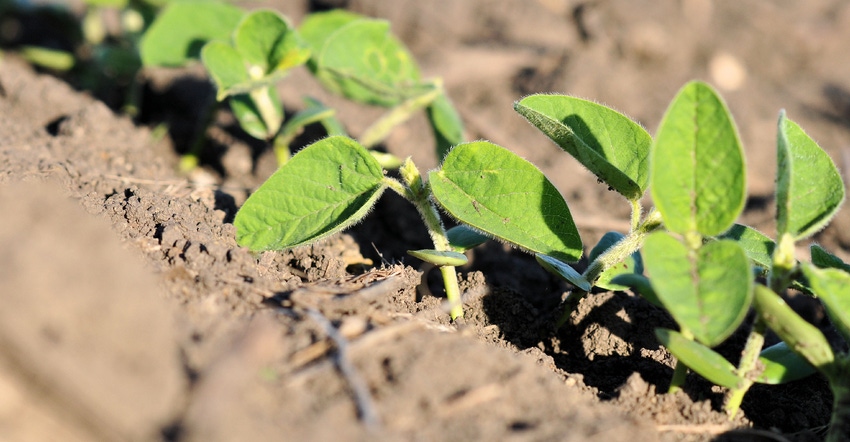
Scott Clement has a new top-end for soybeans on his Bloomington, Ill., farm: 100,000 seeds per acre. He’s used that rate — 30% less than what he used to plant — across his farm for two years. And he’s had some of the best yields in his area.
Clement has run four years of trials that range up to 140,000 soybeans per acre and hasn’t found an economic advantage to any population over 80,000 seeds — meaning even though yields are lower some years with lower rates, the savings in treated soybean seed costs make up for the loss until populations go below 80,000 seeds per acre.
“It turns out, there isn’t really an economic difference until 80,000 seeds per acre. Now all of a sudden, it’s a race to find the right number above that,” Clement says. “And with the right precision equipment, it might even be below, I can’t say.”
In 2021, he plans to experiment with populations ranging from 60,000 to 100,000 seeds per acre. The University of Wisconsin also didn’t see a yield difference until rates fell below 80,000 seeds per acre over the last two growing seasons, says Shawn Conley, soybean and wheat specialist with UW-Extension.
Clement is sure 100,000 is “still too high,” but Conley says he’s made good progress. He advises farmers on high-quality ground like Clement’s to use no more than 120,000 seeds per acre.
“When you are in lower-productivity soil — heavy clay content, gravel — then you need more seeds in those situations,” Conley says.
Agronomist John McGillicuddy says he’s precision-planted soybeans as low as 50,000 seeds per acre without a yield reduction, thanks in part to 99% seed singulation with technology like vDrive and vSet from Precision Planting. Soybean farmers who don’t use that technology get closer to 95% singulation. For his clients, his prescriptions rarely go below 95,000 seeds per acre.
“Our nature is to fudge high. If we go from 80 to 95 or 100,000, we’ll probably get a yield increase a small percentage of the time, but we’re only making more money about 30% of the time after you factor in seed costs,” McGillicuddy says.
He notes that because of major delays in planting, 2019 was a year where having a higher rate should have paid off, but that fields planted at 140,000 seeds per acre were no better off in terms of profitability than fields with 100,000 seeds per acre.
“Even in 2019, 100,000 seeds per acre was a safe bet,” McGillicuddy says.
Agronomic decisions
Clement doesn’t see a difference in weed control between 80,000 and 140,000 seeds per acre, but even though he doesn’t have weed control concerns, he’s playing it safe and using trials before taking most of his acreage down from 100,000 seeds per acre.
As he prepares his precision planter for spring planting, he says he likely will remove his seed firmers for soybeans. He says doing so will get him closer to a “picket fence” stand, which is important for establishing a uniform canopy and shading out weeds.
McGillicuddy says that for 30-inch rows, he’s seen 80,000-seeds-per-acre fields reach canopy more quickly than 130,000-seeds-per-acre fields. “The difference is all in the branching,” he says.
McGillicuddy says soybeans in lower populations with precise spacing tend to branch more. More branches equal more nodes and more potential pod sites — which have the added benefit of having more resources to themselves.
“You want to increase the number of nodes you establish without increasing wasted resources on things like extra foliage, extra leaves, plants that are going to drop pods and die, etc.,” McGillicuddy says. “When they drop pods in July to early August, sometimes clear into September, to me they’re just saying they’re running out of something. And maybe they’re running out of it because we diverted it with overcrowding: whether it’s nutrients, water or sunshine.”
Soybean genetics
Conley says soybean breeders have spent decades selecting for yield, and in the process, have brought along other traits. This includes the ability to put more yield on branches.
“Breeders didn’t do this on purpose. But over the last three years, they’ve added three times the amount of yield to branches than we saw with germplasm 40 years ago,” Conley says.
Part of the success of low-population fields is precise placement, Clement says. Soybeans selected for branching grow best when they’re well-distanced from early-season neighbors.
“You can’t get the singulation you need at the higher populations. The planter just can’t drive that many seeds out; you’ll get plants on top of each other,” Clement says. “I’m confident 100,000 is my top end, and in 2021, I’ll test lower and lower.”
About the Author(s)
You May Also Like




